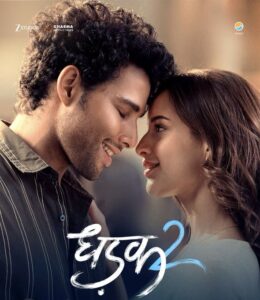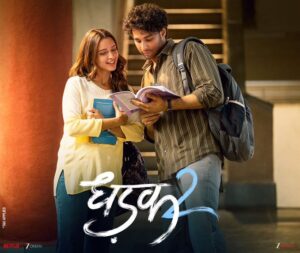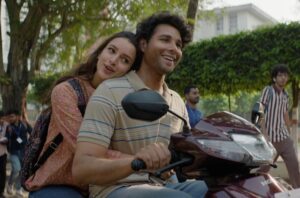
Dhadak 2’ makes a conscious effort to avoid the missteps of its predecessor. It effectively conveys the themes of Dalit resistance and feminism with greater sensitivity and depth.
The 2018 film ‘Dhadak’ was a Hindi remake of the 2016 Marathi hit ‘Sairat’, which powerfully addressed caste-based discrimination and honour killings through a love story. However, for those who watched ‘Dhadak’ after experiencing ‘Sairat’, the Bollywood-style gloss felt jarring—diluting the gravity of the original’s message and undermining the impact of a landmark film.
Following the same theme as ‘Sairat’, the Tamil film industry delivered ‘Pariyerum Perumal’ in 2018—an iconic work widely revered by true cinema lovers across India. Now, ‘Dhadak 2’ arrives as its Hindi remake, this time directed by Shazia Iqbal. Unlike its predecessor, the film makes a clear effort not to repeat the missteps of ‘Dhadak’. It succeeds in conveying the message of Dalit struggle and feminism with much-needed authenticity. But the real question is—does it manage to win hearts? Let’s find out…
What is the story of ‘Dhadak 2’?
The protagonist of ‘Dhadak 2’ is Nilesh Ahirwar (played by Siddhant Chaturvedi), a young man raised in the Dalit colony of the city. Having endured caste-based discrimination since childhood, Nilesh aspires to become a lawyer—driven by a deep desire to fulfill his mother’s long-cherished dream.
Vidhi Bhardwaj (Tripti Dimri) belongs to a Brahmin family with a three-generation legacy in the legal profession. Determined to uphold this tradition, she too dreams of becoming a lawyer. Her path crosses with Nilesh at a wedding, where he’s playing the drums alongside boys from his colony. What begins as a fleeting interaction soon blossoms into a love story as their journeys continue at the Law University.
#Dhadak2Review 🎬
⭐️⭐️⭐A compelling blend of realism and emotion, Dhadak 2 stands out for its grounded storytelling and raw intensity.
Siddhant Chaturvedi delivers a breakout performance, while Triptii Dimri lends quiet depth to her role.Despite a slightly underwhelming… pic.twitter.com/lX31BZB5gF
— Sagar Talkies (@SagarTalkies) August 1, 2025
But in truth, years of caste-based discrimination and humiliation have left Nilesh so scarred that he has forgotten what it means to fight back.
The story also features a psychopathic killer, Shankar (Saurabh Sachdeva), who targets couples that dare to defy caste boundaries in the name of love. His twisted ideology is rooted in his own dark past—he murdered his own sister for falling in love with a Dalit boy. Shankar becomes a weapon for the so-called upper caste families, who use him to ‘protect’ their so-called honour.
Shankar doesn’t take money for his killings—he sees them as acts of ‘righteous duty’. Eventually, Vidhi’s family turns to him to uphold their so-called honour. At this point, the real conflict of ‘Dhadak 2’ emerges: Will Nilesh find the courage to fight for his love? Will he finally raise his voice against the lifelong caste-based humiliation he has endured? This is the heart of ‘Dhadak 2’. Watch the trailer here:
How does ‘Dhadak 2’ treat the Dalit angle?

Even before falling in love with Vidhi, Nilesh’s journey is marked by numerous instances of exploitation rooted in his Dalit identity. ‘Dhadak 2’ also introduces Shekhar (Priyank Tiwari), a fellow Dalit and a passionate student leader at the university. A parallel subplot follows Shekhar’s own love story, his fight for Dalit rights, and the unjust cancellation of his scholarship—a narrative thread that takes a grim and unsettling turn.
Nilesh’s father (Vipin Sharma) works as a performer, often dancing in disguise—a character with his own quiet arc in ‘Dhadak 2’. His mother (Anubha Fatehpura), on the other hand, is a strong-willed leader of their Dalit colony, unafraid to raise her voice for the rights of her community. A pivotal incident in her past becomes a turning point in the story, compelling her to steer Nilesh away from Polytechnic and toward studying law—to fight, not just for himself, but for others like them.
All these subplots are designed to build Nilesh’s journey and set the stage for his hero moment. However, the real issue lies in how they’re executed. ‘Dhadak 2’ suffers from a different kind of Bollywood flaw—it tries too hard to hammer its message into the audience’s eyes, ears, and mind, leaving little room for subtlety or emotional nuance.
In its use of symbols and signs, ‘Dhadak 2’ falls short of the cinematic language now expected from films that tackle serious social issues. From predictable imagery like portraits of Dr. B.R. Ambedkar, blue-colored caste references, and Gautam Buddha’s photos in homes, to the outdated choice of darkening a fair-skinned actor to fit the role—these visual tropes feel tired and formulaic. What once felt powerful now risks coming across as performative and unimaginative.
Setting aside its treatment-related shortcomings, ‘Dhadak 2’ stands strong in portraying the struggles at the heart of its story. Whether it’s the assertion of Dalit identity or a young woman challenging patriarchal control at home, the film manages to land on the right side of sensitivity. In a space where Bollywood often stumbles with such themes, ‘Dhadak 2’ surprisingly succeeds in handling them with a degree of honesty and care.
The love story in ‘Dhadak 2

At its core, the plot of ‘Dhadak 2’ can be summed up in one line: how caste becomes the villain in Nilesh and Vidhi’s love story. But for that conflict to truly resonate, the emotional depth of their relationship needed to be just as compelling. Unfortunately, the film becomes so absorbed in highlighting Nilesh’s Dalit identity and personal struggles that the love story loses its weight, lacking the emotional intensity it demands.
From a writing perspective, Vidhi’s character comes across as underdeveloped. As a Brahmin girl who falls in love with a Dalit boy, she appears largely unaware of the social gravity of their relationship throughout the film. While it’s understandable that she isn’t initially involved in her family’s actions against Nilesh, her response after learning the truth feels vague and emotionally inconsistent—leaving her character confused and lacking the depth the story demands.
In ‘Dhadak 2’, the lead female character is given the arc of a young woman trying to assert her identity within a male-dominated household. While this gives her a separate struggle, the treatment of this subplot feels basic and underdeveloped. As the film progresses, Vidhi’s personal battle begins to distract from Nilesh’s central journey, creating a narrative imbalance rather than a meaningful parallel.
READ ALSO – Chinese E-Commerce Giant Removes Lord Jagannath Doormat After Backlash
How is the work of the actors?
Siddhant Chaturvedi delivers a deeply committed performance as Nilesh—his hard work is visible in every frame. Had the writing of Dhadak 2 been stronger and the screenplay more focused, this could have easily been the defining film of his career. He especially shines in the emotionally charged climax, where he truly gives it his all. Tripti Dimri once again fits seamlessly into the role of a small-town girl with big dreams, but the screenplay doesn’t offer her enough strong moments to leave a lasting impact.

Priyank Tiwari delivers a solid performance as Shekhar, bringing depth and conviction to the role. Saad Bilgrami also leaves a mark with his portrayal in a negative shade. Vipin Sharma, despite limited screen time, delivers a memorable and energetic performance. Anubha is impressive as Nilesh’s mother—so much so that you wish she had more scenes. Similarly, Zakir Hussain as the university principal is compelling, and his presence leaves you wanting more.
Saurabh Sachdeva is the standout in dhadak 2 , delivering a chilling performance as the maniacal killer. His precision is evident in every expression, glance, and movement—making the character truly unsettling. Perhaps the greatest strength of dhadak 2 lies in its cast: despite the shortcomings in writing, every actor brings depth and intensity to their role, collectively adding weight and credibility to the film.
Overall, dhadak 2 had all the ingredients to be a powerful film, but weak writing and a formulaic treatment hold it back, making it feel somewhat ordinary. The second half does pick up, with Nilesh’s struggle creating emotional momentum, but much of the screenplay feels mechanical and predictable. While the songs are melodious, they interrupt the narrative flow in a typical, uninspired manner. Still, where the film truly succeeds is in its message—it remains sincere and impactful in conveying the realities of caste and identity.
